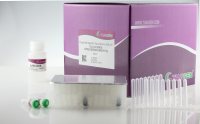DNA Extraction from Archival Formali
互联网
DNA Extraction from Archival Formalin-fixed, Paraffin-embed allowfullscreen='true'ded Tissue Sections
Author: Shi et al. Source: Contributed by APostodoc Abstract: Describes two methods of extracting DNA from archived, paraffin-embed allowfullscreen='true'ded sections. One is the standard non-heating enzymatic digestion method; the other is heating method based on the principles of the antigen retrieval technique, which yields better DNA quantity.
________________________________________
Section 1. Non-heating DNA Extraction Protocol
1.Cut paraffin block at 10 µm and collected in an autoclaved plastic microtube (1.5 ml).
2.Add 1 ml xylene to the microtube containing tissue sections for 30 min for two changes.
3.Add 100% and 75% ethanol for 30 min with two changes.
4.Wash with PBS for 15 min with two changes .
5.Add 500 µl of lysis buffer (proteinase K 20 mg/ml, 50 µl, 1 M Tris-HCl solution 10 µl, 0.5 M EDTA 2 µl, 10% SDS 100 µl, and distilled water 838 ml) .
6.Incubated at 52℃overnight until all tissue fragments were dissolved completely.
7.Add 500 µl phenol:chloroform:isopropanol alcohol at 25:24:1 to the de-waxed tissue.
8.Mix by vortex .
9.Centrifugation at RT, 12,000 x g for 10 min .
10.Transfer the supernatant fluid to an autoclaved microtube using a 100-µl pipette.
11.Add one volume of chloroform to the supernatant, mixed by vortexing.
12.Centrifuged at 12,000 x g for 5 min.
13.Carefully remove the upper aqueous supernatant to another fresh microtube.
14.Adding 0.1 volume of 3 M sodium acetate to the new tube.
15.Mix by vortexing.
16.Add 1 volume of isopropanol, and incubate at -20℃ overnight.
17.The precipitated DNA was centrifuged at 12,000 x g at 4℃.
18.Discard the supernatant fluid and wash once with 75% ethanol.
19.Collect the extracted DNA after further centrifugation.
20.Dissolve the final yield of DNA in 50 µl distilled water after drying completely in a hood.
Section 2. Heating Protocol for DNA Extraction
Overview
According to Shi et al, heating before following the standard protocol above can get high DNA yield.
Materials and Reagents
1.Universal Buffer Solution
Add 28.6 mM of each chemical
Citrate acid,
KH2PO4,
H3BO3,
Diethylbarbituric acid.
Adjust pH to 9 using 0.2 N sodium hydroxide
Procedure
1.Add 500 µl universal buffer solution at pH 9 to a microtube containing a 20-µm tissue section .
2.Heat at 120℃ using an autoclave for 20 min.
3.Allow the tube to cool for 5 min.
4.Follow the standard protocol above but omitting the enzyme digestion step.
Reference
Shi et al, Journal of Histochemistry and Cytochemistry, Vol. 50, 1005-1011, August 2002.






